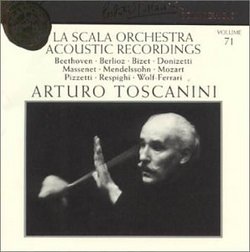| All Artists: Toscanini, NBC Title: La Scala Acoustic Recordings Members Wishing: 0 Total Copies: 0 Label: RCA Release Date: 4/14/1992 Genres: Special Interest, Classical Styles: Marches, Opera & Classical Vocal, Historical Periods, Classical (c.1770-1830), Symphonies Number of Discs: 1 SwapaCD Credits: 1 UPC: 090266031528 |
Search - Toscanini, NBC :: La Scala Acoustic Recordings
 | Toscanini, NBC La Scala Acoustic Recordings Genres: Special Interest, Classical
|
Larger Image |
CD Details |
CD ReviewsFor Fanatics of Toscanini & Collectors of Very Old Records 09/17/1998 (2 out of 5 stars) "There are no other acoustical recordings available of standard repertoire classical orchestral pieces quite like these unique disks!Toscanini and his La Scala Orchestra worked like fiends before a large recording horn in Camden, New Jersey, in 1921 to accomplish these Red Seal sides, which were "state of the art" in the period before the microphone and electronics were wedded to the phonograph. But to today's ears, the results are peculiar and uningratiating: the balances strange, the instrumental timbres odd, the pickup close and claustrophobic. Yet the intensity and precision of these propulsive readings contrast dramatically with the cranky, clumsy, and affected recordings made by other maestros during the acoustical period that ended around 1925.Violin and piano solos, and the singing voice, were taken down well by the acoustical process: we can still enjoy Caruso, Kreisler, Heifetz, or Rachmaninoff's old Red Seals. But most if not nearly all collectors "cut off" their interest in orchestral recordings made before about 1926 or '27, when the early electrical engineers learned how to record a fairly wide and natural dynamic range, and to pick up the acoustical ambience of a real recording hall.Toscanini displays his severe precision, and is fully the man you would expect from his broadcasts of the thirties and forties: once, during the old NBC radio show "Toscanini - The Man Behind the Legend" in the sixties, a composite was made of the 1921 Beethoven 5th excerpts herein and the famous broadcast recording from 1952. Heard over transcontinental network AM radio, there wasn't too much audible difference in style, balance, and interpretation (not to mention sound); but audited today, from digitized transfers, there seem to be several orders of magnitude of difference. The old acoustic is merely a funky sounding oddity, while the 1952 audiotape of the radio/TV simulcast has exceptionally realistic, crisp high fidelity and accuracy (not significantly inferior in detail to any number of modern stereo all-digital recordings!)At least this set provides the opportunity of hearing some unusual pieces under the Maestro's direction: the pleasant excerpt "Le quai du porte de Famagouste" from the "Pisanella" Suite by Pizzetti (recorded in stereo in the sixties by Gardelli on a superb Decca / London LP); the "Gagliarda" from one of Respighi's "Ancient Dances and Airs" suites; and the "Fete Boheme" from Massenet's "Scenes Pittoresques" Suite. I once owned a mint-condition copy of the last item on a single-sided Victor Red Seal 78 rpm disk, and I can testify that one cannot really do much to enhance the sound of an acoustical recording!At least this issue is much better than the very highly compressed copy issued on a private LP by the Clyde Key / Toscanini Society in the sixties: so much audio limiting was done to squeeze all the recordings onto two sides of one LP that the transfers were vastly inferior to the relatively vital sound of the actual shellac disks; this "purist" authorized edition by RCA is much to be preferred." Toscanini's first recordings Robert E. Nylund | Ft. Wayne, Indiana United States | 03/02/2006 (4 out of 5 stars) "Many famous conductors had already been making recordings for several years when Arturo Toscanini was finally persuaded by the Victor Talking Machine Company in Camden, New Jersey, to make some orchestral recordings with the Scala Orchestra in 1920-21.
The Italian ensemble had been touring the U.S. and they took time out to make a series of 78-rpm acoustical discs in the "church" studio at Camden. Some of Enrico Caruso's later recordings also took place in this very large facility, which utilized a very large horn to pick up as much of the orchestra as possible. Sometimes, smaller horns were connected to the recording equipment to record principal players. Admittedly, the acoustical process had limited frequence response. By 1920 and 1921, when these recordings were made, the process had reached its highest possiblities, so much more could be recorded. Already, however, Bell Laboratories was developing a new recording process that would use carbon microphones to pick up more sound; that process would be adopted by Victor in the spring of 1925 to record the Philadelphia Orchestra under Leopold Stokowski. Despite the limited possibilities of acoustical recordings, they always had very good bass tones and they sounded quite good when played on a full size Victrola. Some of this can be approximated, however, through digital technology and it's actually possible to hear more today than was possible on vintage phonographs. One good thing about Toscanini's acoustical discs is that they give us an idea of the remarkable energy he utilized in his earlier performances. There is is incredible playing by the Italian musicians in most of the recordings. A particularly good example is the overture to "Don Pasquale," which has virtually the same playing time as Toscanini's 1952 recording with the NBC Symphony Orchestra. The woodwinds are particularly excellent in this performance and, quite remarkably, one can even heard the tympani (rarely used in American acoustical recordings). Overall, these are exciting glimpses of Toscanini in his "younger" years, long before the more famous NBC Symphony concerts and recordings. They are often very charming and very delightful. They certainly have historical value. Toscanini would not record again until 1926, when he made a single 78-rpm electrical recording for the Brunswick Company with the New York Philharmonic. But that's another story... " |

 Track Listings (14) - Disc #1
Track Listings (14) - Disc #1